The Turkish MOOC: A hybrid mediation tool for face-to-face and distance learning
The aim of the Turkish MOOC is to acquire a rudimentary knowledge of the Turkish language, based on simple written and oral tasks referenced at CEFR level A1[2]: using greetings and polite expressions, introducing oneself, traveling, buying tickets, booking a hotel room, ordering in a restaurant, shopping and making purchases.
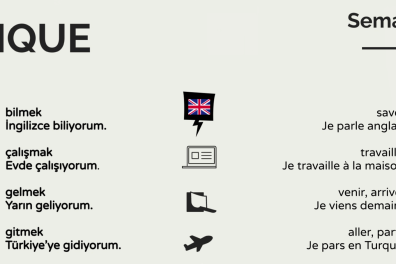
The target audience is broad and diverse, ranging from those who plan to visit Turkey for personal or professional reasons, to those who are curious to discover a foreign language and pursue its study afterwards. The MOOC is particularly aimed at the business world, but also at anyone who will be visiting the country whose language is taught in the MOOC. In addition, it could be used in the service of continuing education, particularly in the initial phase.
The first step is a call for tenders: how do you get people to sign up for a language MOOC? The general presentation teaser for Inalco's MOOCs, gives the general direction of the pedagogical offer. More specifically, for the Turkish MOOC, we've made reference to symbolic names: Molière's words on the Turkish language in the mouth of the Bourgeois Gentilhomme: "Voilà une langue admirable, que ce turc!", and Mozart's notes in filigree with his Turkish March.
However, this isn't just a publicity stunt! The presentation of the language, and to a certain extent the culture, have an important place.
Through its rhythm and the quality of its image, the trailer must "make learners want" to enroll, but it must also introduce the target audience to the content of the course and its objectives, and present as detailed a lesson plan as possible (by week and by day), with information on the progress of the lessons and the workload to be expected. Finally, it must present the teaching team, assessment methods and follow-up by teachers/tutors on the forum. Interested learners should also be informed of the conditions for obtaining a certificate and ECTS points.
We're asked not to emphasize the difficulties of learning a foreign language from the outset, on the contrary, we highlight the facilities, underline the assets such as the grammatical regularity of the Turkish language, the absence of gender, the absence of agreement, the familiarity of the alphabet... We also specify the advantages offered by the lexical, phonetic and logical proximities between Turkish and French.
From attractiveness to the test
Once the audience has been won over, it needs to be provided with the material to learn in the most effective way possible. To use the title of the recent colloquium[3] of the research team PLIDAM/Inalco (Plurality of languages and identities: didactics, acquisition, mediation), it's all about taming distance to reach a distant audience.
The biggest difficulty to overcome at the outset in learning the Turkish language is suffixation and vowel harmony. In this respect, we propose pedagogical solutions to make the suffixation system and vowel harmony comprehensible in self-study. To this end, filmed dialogues are replayed three times:
- in Turkish without subtitles,
- in Turkish with bilingual Turkish-French subtitles,
- phrases spoken one by one facing the camera and displayed alongside.
In this way, we proceed in stages, in order to achieve progressive memorization and acquisition of everyday phrases.
In addition, for those who wish to deepen their knowledge, the grammar videos explain the various linguistic or cultural elements present in the dialogues, and provide more theoretical explanations. They systematically include tables summarizing the rules of harmony, as well as the complete conjugation of verbs.
Design and production phases
MOOCs are distance learning courses combining traditional pedagogy and new technologies: the sequences and animations must serve the objectives and methods previously designed, then technically produced[4].
The design phase, which forms the basis of the project, comprises several stages: needs analysis, content writing, scripting, graphic and editorial charter.
Like most French MOOCs, Inalco's MOOCs are hosted on the France Université Numérique (FUN) platform.
The entire course is made up of three blocks:
Week 0 - Getting to grips with the platform, welcome, presentation of the language and its alphabet,
Weeks 1 to 5 - Central block made up of 5 themed sequences covering presentation, orientation, catering, accommodation and shopping. Each sequence includes filmed dialogues with grammatical and lexical explanations, and closes with exercises.
Week 6 - Final check and general assessment.
Turkish MOOC course presentation page announcing the objectives for week 1
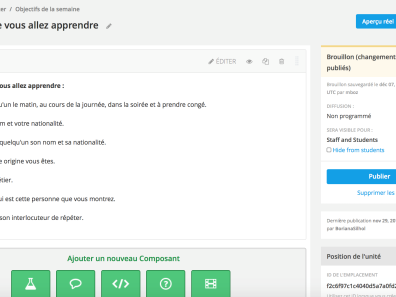
The design phase consists first of all in defining the knowledge to be provided to the learner, the skills to be acquired during this training, targeting the major themes of the course and planning a general sequence of content.
The work continues with the development of the five sequences following a distance learning method to ensure that learning is as effective as possible; it must always be borne in mind that the learner is alone in front of his screen, faced with pedagogical tasks to perform in order to learn and eventually to prove his acquired skills in order to obtain a certificate.
The course must therefore be designed taking into account the constraints linked to this type of training (distance, duration, modalities...), as well as the MOOC format (5 weeks, absence of teacher-learner interaction...).
Writing the scenario is an important stage in the design process, making it possible to finalize the chosen texts, set the sequence of courses and sequences, and recommend the illustration of content (photos, PowerPoint, videos). The script will thus facilitate the production of sequences and the work of realization.
Exercises
The MOOC "Turkish Language Contact Kit" offers self-correcting exercises. They are spread throughout the course and come in several types of exercise:
- QCM
- Hole-filled texts with drop-down list
- Hole-filled texts with word or phrase input
- Small text to listen to (a short text at the end of each week in connection with the weekly theme) and associated exercises.
Page showing an exercise in preparation on the FUN platform
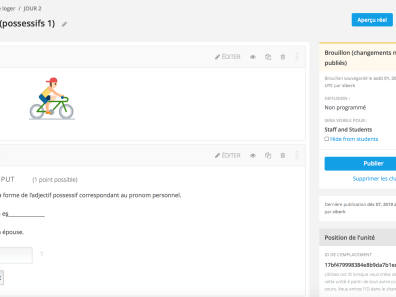
Knowledge/skills
The MOOC provides skills defined and referenced at level A1 of the CEFR: it puts the learner in a position to understand and use familiar, everyday expressions and simple statements aimed at satisfying concrete needs. The learner should be able to introduce himself or herself and someone else, and ask questions about that person - for example, where he or she lives, his or her job, hobbies, etc. - and answer the same type of questions. - and answer the same type of questions. The lexicon used is chosen according to its frequency and usefulness in this type of communication.
Learning is centered on fundamental skills:
- Speaking comprehension, reading comprehension: reading familiar names, words and simple sentences, particularly for orientation: indication, sign, street name, bus or metro station, map or menu, index card...
- Speaking in interaction and continuously: the learner can communicate, in a simple way, provided the interlocutor is willing to repeat or rephrase his/her sentences more slowly and to help him/her formulate what he/she is trying to say. He can ask and answer simple questions about what he needs immediately. He will learn everyday expressions of friendliness and politeness.
- Written expression: the learner can fill in personal details in a questionnaire, entering his contact details, name, nationality and address on a hotel form, for example.
Actional perspectives
Learning is centered around the completion of simple, authentic "real-life" tasks encountered by the traveler arriving in the country with business or tourism motives. Learners should be able to:
- greet someone,
- introduce themselves: learners are able to state their identity, spell their name, give contact details; address and telephone number, say their date and place of birth, age, sex, marital status, nationality, where they come from, what they do, understand and ask similar information from their interlocutors,
- fill in a simple form with their name, address, nationality and marital status,
- ask for directions while out and about,
- use polite expressions like "excuse me", "please", "sorry", etc., grasp the meaning of gestures through a socio-cultural approach,
- place an order at a café, restaurant, kiosk, ...
- make a purchase, using gestures (pointing to the object) to support the verbal referent.
Content - Teaching resources
- Approximately 1h30 per week of work on filmed dialogues and grammatical explanations (printable cards).
- Audio recordings: presentation of the language, short texts read.
- Exercises designed for learning and point exercises for assessment.
- Accompanying resources: lexicon for each sequence (cards with images, each word used in a sentence), cultural, culinary and musical elements.
- Basic bibliography
- Forum: exchanges between learners and teachers / tutors.
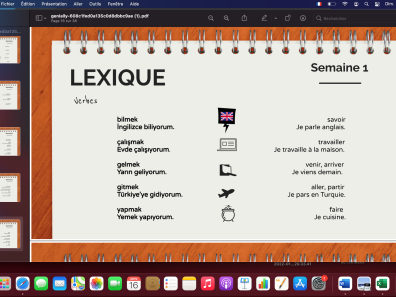
Weak points
The MOOC is an educational offering with modest content, having great accessibility. At the same time, it suffers from the distance and physical absence of the teacher-learner pair and lack of reciprocal interaction. Admittedly, a forum is set up during the training period for exchanges with teachers/tutors and between learners from different linguistic and cultural areas to answer their questions, but this does not replace the indispensable face-to-face teacher-learner interaction, especially for phonetic acquisition. The distance between teacher and learner prevents us from hearing learners pronounce. How do they pronounce, for example, the dotless i and the rolled r in Turkish? How far can you learn a language just by listening and writing?
In addition, in the forum, chatting with learners live and in real time won't always be possible with distant countries because of the time difference. On the other hand, an online community of learners is a kind of digital global classroom that can stimulate learning. There will be discussion/exchange and language tasks to be completed on the forum, a kind of social network where learners from all over the world can meet up, talk, exchange with each other, ask tutors their questions.
Concluding remarks
The MOOC "Turkish Language Contact Kit" is an introductory course to the language, supported by a variety of resources. The MOOC is therefore a complementary tool to face-to-face teaching for our courses at Inalco, since in one way or another we plan to integrate it into introductory classes. The filmed dialogues and grammar explanation videos can be reused in class or in the language lab, or given as self-study work.
The MOOC is free and open to all. But we're currently moving towards an economic/certification model for those who go all the way and seek validation for their efforts. Its pedagogical value is increasingly measured in terms of ECTS credits.
We are therefore well and truly faced with a digital innovation likely to attract a large number of curious people who can turn into learners. To convince ourselves of this, we need only recall the statistics of the first experiments carried out at Inalco:
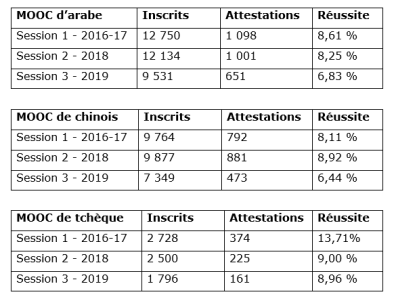
Certainly, the drop-out rate is high, but the impact of this tool on such a wide audience is not insignificant given the number of students enrolled in language courses in higher education.
This tool is a pedagogical challenge in the digital age launched on a planetary scale. Given the explosion in the number and diversity of learner profiles, it's no exaggeration to describe it as a revolutionary pedagogical tool. The MOOC is an additional resource that must be integrated into our teaching practices.
In short, our experience with MOOCs confirms that, from now on, digital culture must be part of our teaching environment. It's distance learning, of course, but it welcomes learners from all over the world, a pedagogical scenario that was unimaginable just a few years ago. Today's MOOC is an additional tool at the service of learning and mediation between languages and cultures.
Sibel Berk-Bozdemir, Senior lecturer in Turkish linguistics and didactics. Member of the PLIDAM (Plurality of Languages and Identities in Didactics: Acquisition, Mediations) research team
Bibliography
Ollivier, Christian and Puren, Laurent (coord., 2013). Recherches et applications, Le Français dans le monde n°54 (July 2013). Mutations technologiques, nouvelles pratiques sociales et didactique des langues.
Szende, Thomas (2016),The Foreign Language Appropriation Conundrum: Micro Realities & Macro Dynamics, Brussels: PIE - Peter Lang.
Some online sources
Degache, Christian and Mangenot, François (coord., 2007), Echanges exolingues via Internet et appropriation des langues-cultures, Lidil n°36 (December 2007). Grenoble, Ellug.http://alsic.revues.org/134
Dejean-Thircuir, Charlotte and Ciekanski, Maud (coord., 2012), Apprentissage des Langues et Systèmes d'Information et de Communication, Vol. 15, n°2, special issue Epal 2011.
http://alsic.revues.org/2489
Nissen, Elke and Blin, Françoise (coord., 2008), Language Learning and Information and Communication Systems Vol. 11, n°1, special issue Epal 2008.
http://alsic.revues.org/2489
Notes
[1] Inalco's "Contact Kit in Oriental Languages" MOOC project has eight languages: Arabic, Chinese, Czech, Hebrew, Malagasy, Burmese, Mazatec, and Turkish. The first three have already been launched in 2017, with the others in progress.
[2] The Common European Framework of Reference for Languages - Learning, Teaching, Assessing.
[3] "Distances apprivoisées. L'enseignement confiné des langues étrangères", International Colloquium organized by PLIDAM online, June 17-18, 2020.
[4] The platform on which the MOOCs are prepared and put online, FUN (France Université Numérique) uses Open edX (open source) technology.